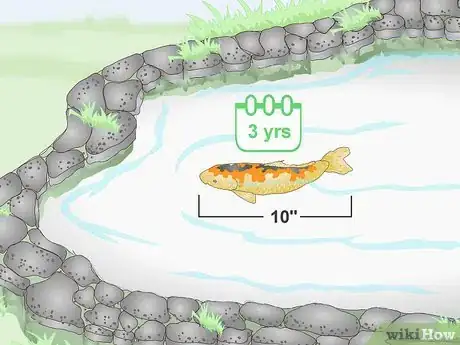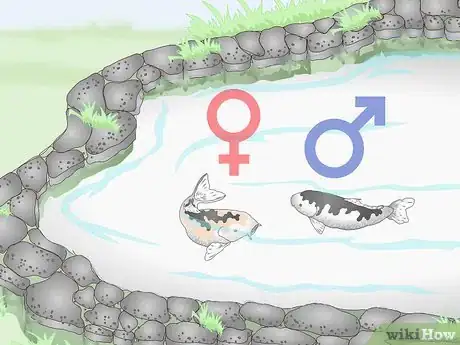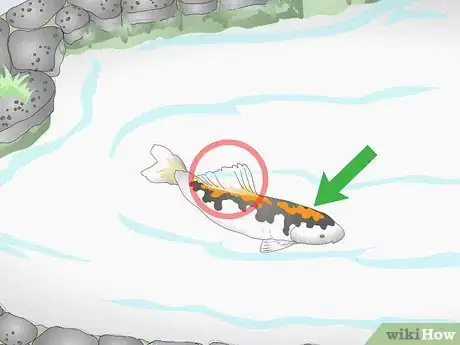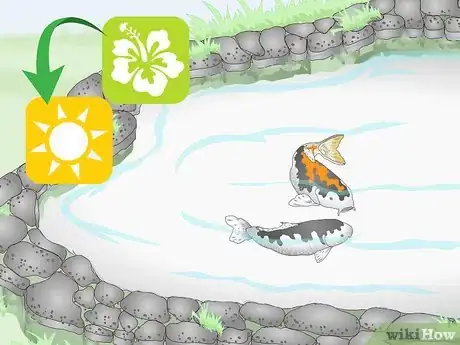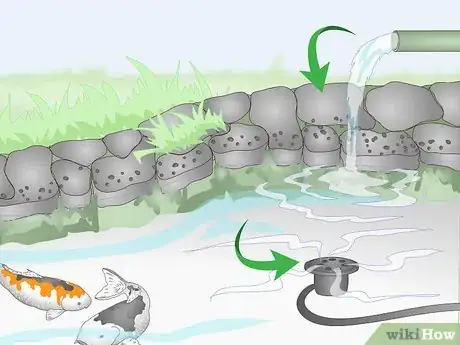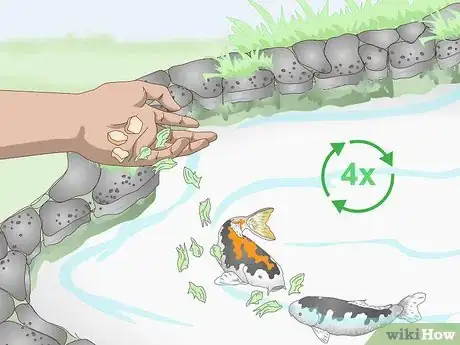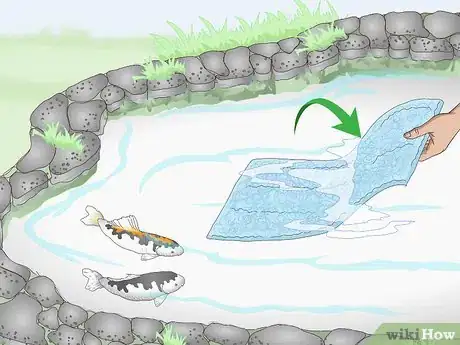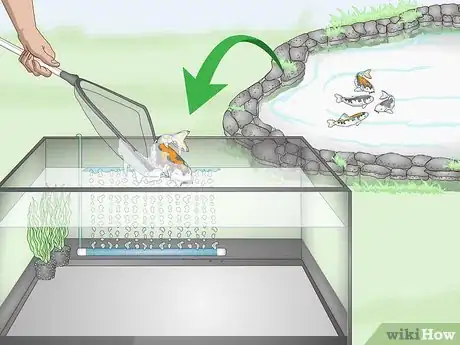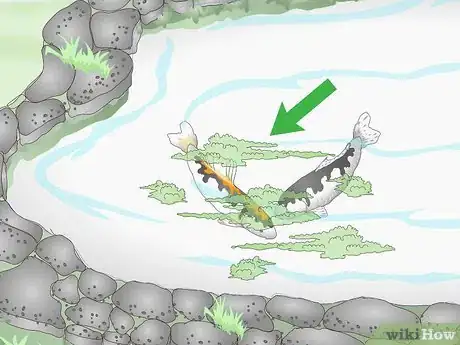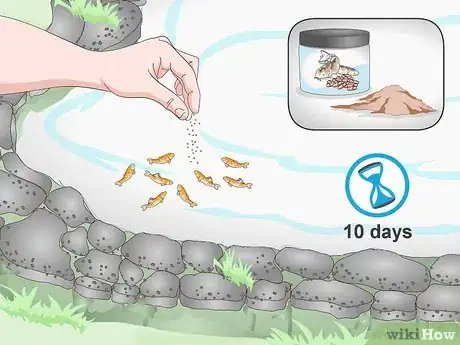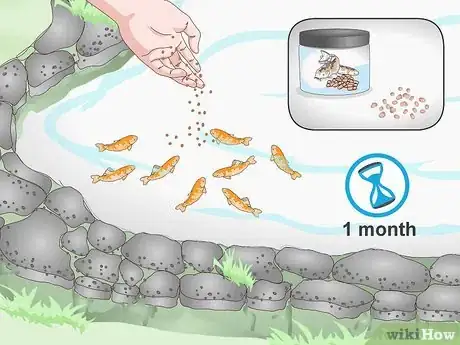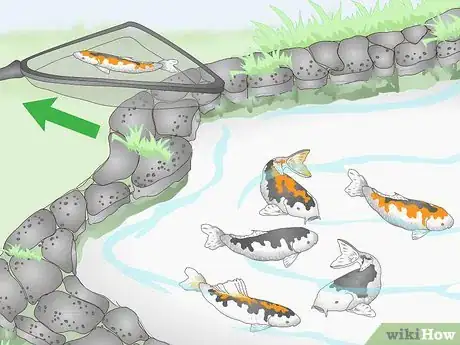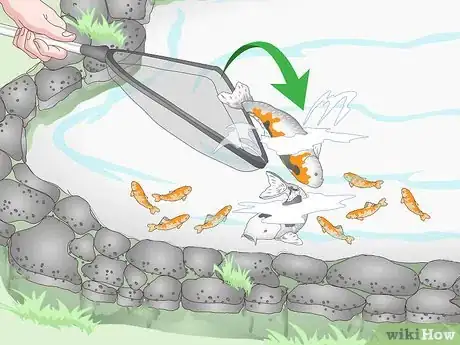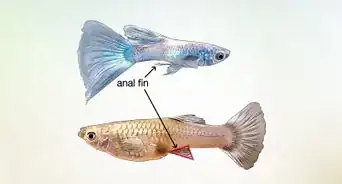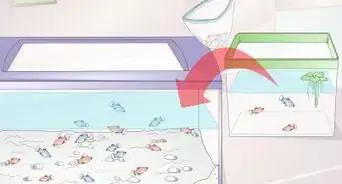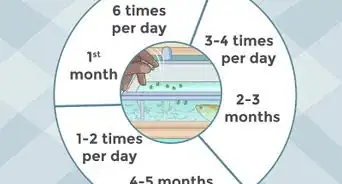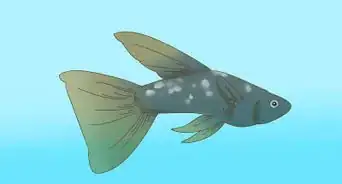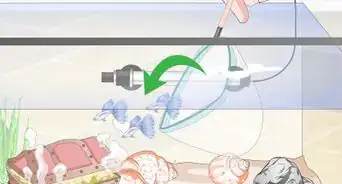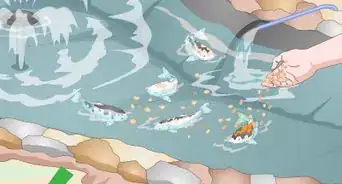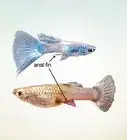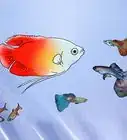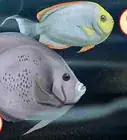This article was co-authored by wikiHow Staff. Our trained team of editors and researchers validate articles for accuracy and comprehensiveness. wikiHow's Content Management Team carefully monitors the work from our editorial staff to ensure that each article is backed by trusted research and meets our high quality standards.
wikiHow marks an article as reader-approved once it receives enough positive feedback. In this case, 93% of readers who voted found the article helpful, earning it our reader-approved status.
This article has been viewed 149,899 times.
Learn more...
Breeding koi can be a lot of fun but is a time-consuming process. To breed koi for a profit, it is important to choose koi that show the physical attributes you are looking for in offspring. Keep the pond clean and free from predators to increase the percentage of koi eggs that will hatch and survive their early weeks of life.
Steps
Choosing Koi to Breed
-
1Choose koi that are at least 3 years old. Koi don’t sexually mature until they are about 3 years old. Wait until they are 3 years old to increase their likelihood of breeding and producing quality offspring.
- Koi are about 10 inches (25 cm) long when they are 3 years old.[1]
-
2Identify at least 1 male and 1 female to stay in the mating pond. Male and female koi generally look quite similar. However, during mating season, the males have small white growths on their pectoral fins and heads. Remove any koi from the pond that you don’t want to breed; otherwise you will end up with unwanted baby koi.
- It is easy to spot males once they start breeding as they will chase the females around the pond.[2]
- It is safe to have multiple male koi in the same pond.
Advertisement -
3Select koi that have attributes you want to replicate. Consider the attributes that you want for your koi offspring. If you want a certain fin shape, choose koi that demonstrate that characteristic. Regardless of what physical characteristics you want, try to choose koi that have healthy looking scales and are at least 10 inches (25 cm) long.
- If you are looking for a certain color, choose koi parents that demonstrate that coloring.
- Avoid using a child’s pet koi for breeding as the koi can suffer torn fins, bruises, cuts and occasionally death, during the breeding process. Take your koi to a vet if you are worried about their injuries.
Making the Right Conditions for Breeding
-
1Breed koi in late-spring or early-summer. Koi tend to breed when the weather is warm and the water temperature has risen. It is important to be prepared as koi can produce up to 1 million eggs.
- If you don’t have the right conditions or enough capacity for baby koi, consider removing the males from the pond during this season. You will need a pond that is 3 feet (0.91 m) deep and 6 feet (1.8 m) by 8 feet (2.4 m) foot wide to house 5 koi. For more koi, you will need a larger pond.
-
2Use a filtration system to keep the water clean. A clean pond is important for the health of the koi and their spawn. Use a specialized koi pond filtration system to keep the water clean during the breeding season. These can be expensive but are necessary for breeding.
- Pond filtration systems can be purchased from pet stores or specialty fish shops for between US$200-US$2000.
- If your pond is particularly dirty or filled with algae, you may need to completely clean it out.
-
3Use a skimmer net to remove any debris or predators from the water. Predators (such as other fish) and debris should be removed from the pond to protect the spawn. Use a skimmer net, or a similar scoop tool, to remove anything that might harm the koi.
- Skimmer nets can be purchased from DIY stores.
- If cats or birds are approaching your pond, cover the pond with netting to protect the koi. Use a piece of netting that is large enough to cover the pond and secure it down with heavy rocks.
-
4Feed your koi 4 times per day while you are trying to breed them. Increase your chances of the koi breeding by keeping them well fed for the month before you breed them. Feed the koi as much as they can finish in 5 minutes. Wholemeal bread, oranges and whole lettuces are nutritional food options.
- Increase the amount of protein you feed your koi, as this helps support their bodies for breeding. Protein supplements can be purchased from a pet store. Follow the feeding instructions on the back of the packet.
-
5Place a fry mat in the pond. This is a flat and sticky mat that gives the koi a place to lay their eggs. If koi can’t find a place to lay their eggs, they won’t always mate. Place the mat in an obvious place at the bottom of the pond.
- Purchase a fry mat from a pet store or a specialty fish shop.
-
6Prepare a separate tank for the adult koi. If you want to breed a large number of koi it is important to remove the adult koi as they will eat many of the eggs. Make sure that the koi tank is clean and has a filter system.
- If you are wanting to breed a small number of koi, leave the adults in the pond.
- Purchase a koi tank from a pet shop. For 2 koi, you will need an aquarium that is at least 100 gallons (380 L).[3]
-
7Leave the koi to mate. This process can happen immediately or can take a few weeks. Don’t worry if the koi don’t look interested in each other initially. A storm, full moon or change in air temperature can help encourage the koi to mate, so be patient and let nature take its course.
- Once the koi have mated, you will see a froth appear on the top of the water and their eggs will be visible on the fry mat.
Caring for Young Koi
-
1Look for froth or scum appearing on the top of the water. This indicates that the spawn has been released. The spawn is immediately fertilized by the male koi and eggs are formed.
- The eggs will hatch after about 4 days.
- If you are breeding the koi for profit, remove the parents out of the pond as soon as you notice the eggs or the presence of froth on the water.
-
2Feed the baby koi powdered koi pellets after 10 days. Crush up koi pellets using a blender or mortar and pestle until they are in a fine powder. Sprinkle the powder over the pond. Pour in enough powder to last the fish about 5 minutes. Feed the koi 4 times per day.
- Continue to feed the baby koi powdered food until they are 4 weeks.
- Over time, you will learn how much food the baby koi will eat during each 5-minute feeding session.
- It can take a few days for the koi to get used to eating the powdered food.
- Feed the fish 10 days after you notice the eggs.
-
3Increase the size of the food once the koi are 1 month old. Start to introduce crumb size pellet pieces once the koi are 4 weeks old. You will still need to crush the pellets but they no longer need to be in a fine powder.
-
4Cull any weak fish if you are breeding for profit. If you have a small pond and want to breed the koi for profit, you will need to cull some of the fish. Identify the koi that are very small, have physical disabilities or aren’t the color patterns you are looking for.
- Make sure that the koi are culled humanely.
- You don’t necessarily need to dispose of the koi. Consider giving them away to friends or family members if they are healthy.
- Koi can be culled at any age, although, it is best to wait until their patterns emerge so that you can choose to keep the koi with your favorite colorings.
-
5Reintroduce parent koi once the baby koi are 3 inches (7.6 cm) long. Once the baby koi start to get bigger, the parent koi become friendly with their offspring. If you have removed the parents from the pond, this is a safe time to reintroduce them.
- Baby koi take approximately 3 months to reach 3 inches (7.6 cm).
Community Q&A
-
QuestionWhat is this breeding mat? Where can I order one?
 Community AnswerYou can get one on Amazon.com, or you can make your own, which would probably be cheaper.
Community AnswerYou can get one on Amazon.com, or you can make your own, which would probably be cheaper. -
QuestionMy carp has little white spots on it. What do I do?
 Community AnswerIt could be ich. This is a bacterial infection. Try talking to your local fish store about actions you can take to stop it, as it can spread quickly and can kill your fish if it persists for too long. Take pictures as well to show your pet store. Make sure your water is clean and clear.
Community AnswerIt could be ich. This is a bacterial infection. Try talking to your local fish store about actions you can take to stop it, as it can spread quickly and can kill your fish if it persists for too long. Take pictures as well to show your pet store. Make sure your water is clean and clear. -
QuestionWhat is the best color pattern for koi?
 Community AnswerI like Kumonryu, it is black and white. There's also the very pretty Kin Kikokuryu, which has gold, black and yellow.
Community AnswerI like Kumonryu, it is black and white. There's also the very pretty Kin Kikokuryu, which has gold, black and yellow.
References
About This Article
To breed koi, wait for late spring or early summer when the water and weather are warm enough. Make sure there are at least 1 male and 1 female in the mating pond you're using. You can spot the male koi during the breeding season, as they have white growths on their pectoral fins and heads. Feed the koi 4 times per day during the breeding season to increase the chances of offspring. Protein supplements, wholemeal bread, oranges, and lettuce are all ideal options. It can also help to place a fry mat at the bottom of the pond. This gives the koi a spot to lay their eggs. Once the conditions are right, wait for 2 - 3 weeks for the koi to mate. Begin feeding the baby koi powdered koi pellets once they are 10 days old and move onto larger pellets as they get bigger. For more information on breeding koi fish, like how to use a filtration system, read on.
